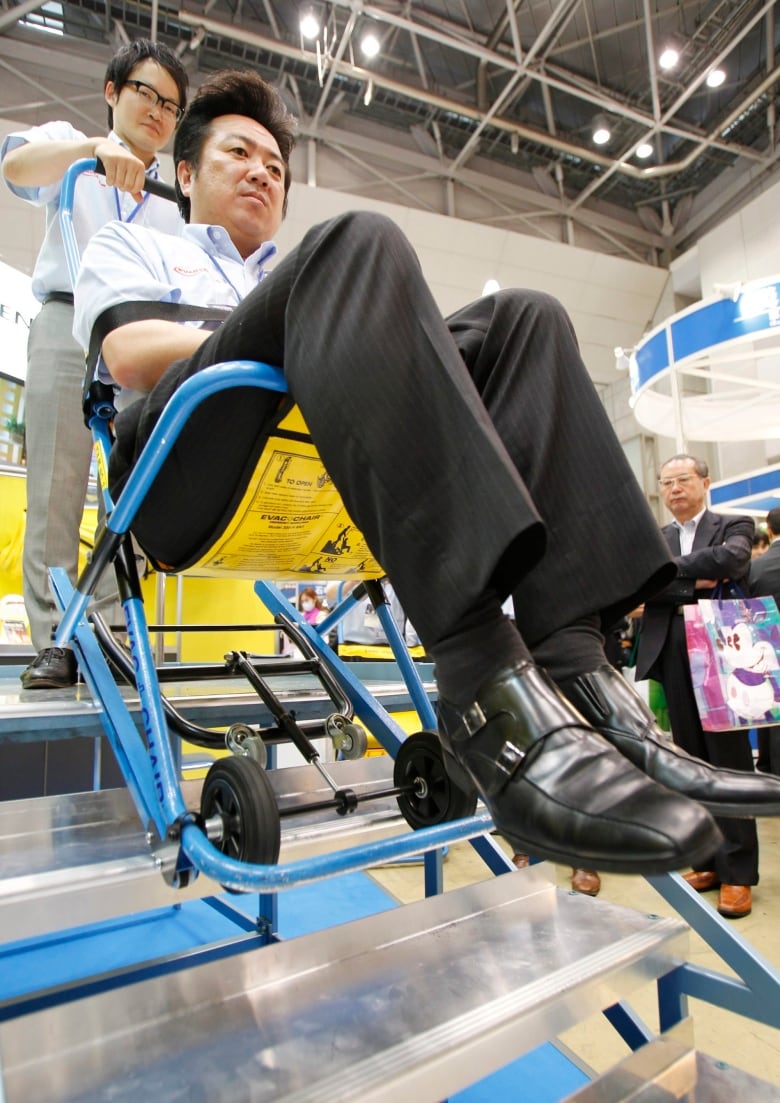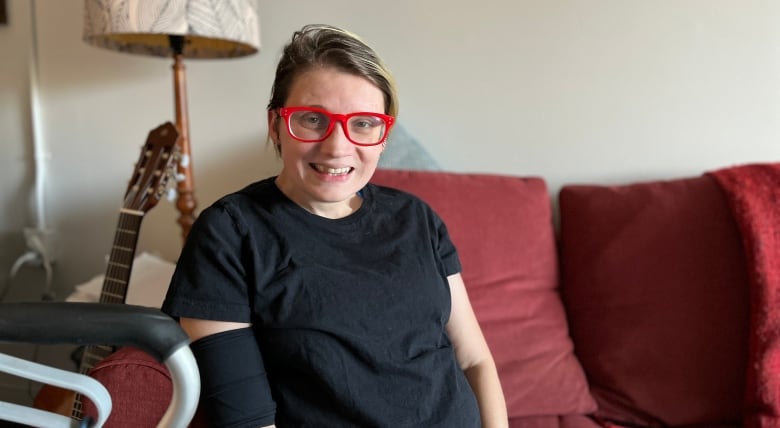
The first time the fire alarm went off in Oda Al-anizi’s high-rise apartment in Toronto, he called security but found that no one knew what to do to help him leave the building in his wheelchair.
“I just waited for the alarm to stop,” Al-anizi said.
“I felt like my life had less value. Does it mean that my life is expendable? Does it mean that an evacuation for me is less important than everybody else?”
Al-anizi has used a wheelchair since he sustained a complete spinal cord injury in a car accident involving a drunk driver when he was 11.
The next time the alarm sounded, Al-anizi said he waited 40 minutes trying to reach building security before firefighters helped him evacuate with an evacuation chair — which can smoothly descend a stairway. The experiences inspired one of Al-anizi’s disability-related comics that he shares on his Instagram.
“Many people messaged me,” he said. “I realized how universal that experience is, as well as the lack of emergency evacuation for people with disabilities.”

The most recent review of the Ontario government’s progress on implementing the Accessibility for Ontarians with Disabilities Act (AODA) considered the current state of emergency procedures for people with disabilities an immediate safety threat.
Rich Donovan, a government-appointed reviewer, issued a “crisis recommendation” to the province in June 2023 to implement clear protocols for all government buildings that include “the immediate, safe evacuation of all individuals within the building” regardless of disability when there is a need to evacuate.
To do that, he urged the province to establish a crisis committee chaired by the premier within a month of tabling his report and to publish the updated government evacuation plans publicly within six months of creating the committee.
Still no new evacuation protocols
But almost a year and a half after receiving Donovan’s recommendations, and 10 months after the province tabled his report, no new emergency plan has been published.
Instead, internal government records CBC Toronto obtained through a freedom of information request show that as recently as this May, the province was still exploring the feasibility of implementing two options to reduce the wait time for evacuating people with disabilities in provincial buildings.
CBC Toronto asked Ontario’s Ministry for Seniors and Accessibility about the current status of those efforts.
In a statement, a spokesperson for Minister Raymond Cho didn’t address specific evacuation options but said the ministry has reviewed all existing processes.
“[The ministry] is now working to actively update and improve building evacuation for all provincial government-owned buildings to ensure the safe evacuation of people with disabilities,” said Wallace Pidgeon, director of communications for Cho.
The most recent review of the Ontario government’s progress implementing the Accessibility for Ontarians with Disabilities Act called the state of emergency procedures for persons with disabilities a ‘crisis.’ Nearly a year and a half later, the province still hasn’t implemented new protocols and advocates say it’s another example of the province failing to prioritize accessibility.
The statement also said the ministry is creating a new volunteer group of people with disabilities to provide their direct experience and feedback on accessibility issues.
For Al-anizi, and other disability advocates CBC Toronto spoke with, the delay implementing new protocols is indicative of how they say the government generally treats people with disabilities.
“It’s further proof of what an abysmal job they are doing with accessibility,” said David Lepofsky, chair of the AODA Alliance, a consumer advocacy group monitoring the legislation’s implementation.
Enacted in 2005, the AODA was intended to make Ontario accessible by 2025. But Donovan’s review found that it was a “near certainty” the province wouldn’t meet that deadline for the 2.9 million people with disabilities in Ontario.
When it comes to implementing that legislation, Pidgeon’s statement said the province “has taken a whole of government approach to addressing accessibility and how AODA compliance is being implemented across the board that focuses on customer service and design of public spaces.”
Province considering evacuation chairs, designated elevator
The current approach to emergency evacuations for people with disabilities in multi-storey buildings in the province is generally to wait for firefighter assistance, according to the internal records government obtained by CBC Toronto.
A slide deck from this May titled “Improving Emergency Response Protocols for OPS Buildings for People with Disabilities” said the ministry was working with the Office of Fire Marshal and other government agencies to “map out options to improve current emergency evacuation procedures in the short and long term.”
Any short-term solutions outlined in the record appeared to be redacted under a freedom of information disclosure exemption for advice to the government.

The options floated as a “long-term approach” in the slide deck were buying evacuation chairs for each floor of all government-owned buildings and researching whether a dedicated elevator could be used to evacuate people with disabilities.
Reviewing liability, cost of options
Considerations for adopting those options included reviewing liability implications, the cost of purchasing the chairs for each floor of nearly 200 government-owned buildings running from $732,000 to $2.9 million and changes that would be needed to building fire safety plans, according to the record.
In its statement, the ministry didn’t acknowledge its evaluation of those options and didn’t answer questions about what short-term solutions it was implementing or considering.
In his own experience, Al-anizi was impressed with the evacuation chair.
“It should be a part of the arsenal, a tool in the arsenal,” he said. “But not every disability is the same, so it’s not going to work for everybody.”

Keeping a designated elevator running to evacuate people with disabilities would be ideal if it could be done safely, said Kate Welsh, a disability inclusion educator who uses a walker and a wheelchair.
“[That way] people have autonomy, you don’t need to necessarily have their chair carried and have them carried — it’s a lot more dignity,” they said.
Above all, Welsh, Al-anizi, Lepofsky and Anthony Frisina, a spokesperson for the Ontario Disability Coalition, said the province needs to consult with the disability community and accessibility experts to establish these new emergency protocols.
“There needs to be an intervention through the disability community to have our say not only from a standpoint that we’re listened to, but we’re heard,” said Frisina.
Wherever the government lands with these protocols, Al-anizi said the plan needs to be clear and communicated to the public.
“In an emergency, you can’t afford ambiguity.”
